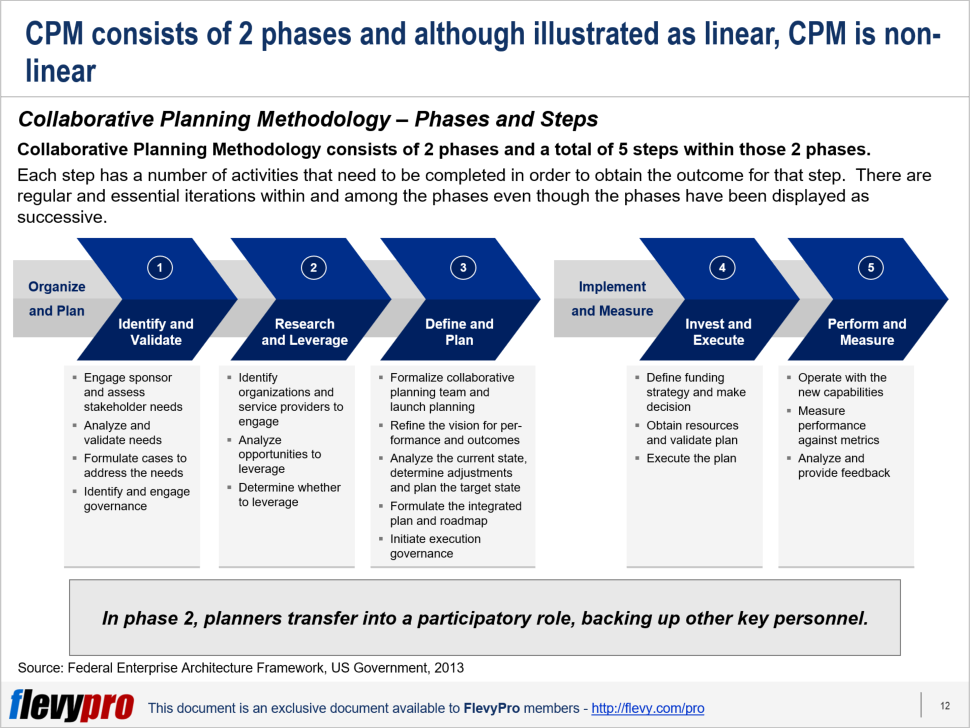Business and technology resources are aligned using Enterprise Architecture (EA) in order to achieve strategic results, improve organizational performance, achieve Cost Optimization and Operational Excellence, and guide departments to fulfill their central missions more efficaciously.
Federal Enterprise Architecture Framework (FEAF) does that for any U.S. federal agency and helps systems transcend interagency boundaries.
Planning is one of the most important elements for bringing about change in an organization, if not the most important. Planning methodology for the Federal Enterprise Architecture Framework is called Collaborative Planning Methodology (CPM).
Collaborative Planning Methodology is the next-generation successor to Federal Segment Architecture Methodology (FSAM).
Collaborative Planning Methodology encompasses 2 phases and a total of 5 steps under these phases:
Organize and Plan phase lets planners facilitate partnership between sponsors and various stakeholders in order to ascertain and prioritize requirements, explore other organizations with same needs, and devise plans to tackle the stated requirements.
Implement and Measure phase has the planners in assist role to other key personnel working to implement and monitor change related activities by supporting investment, procurement, implementation, and performance measurement actions and decisions.
Each step under these 2 phases has a number of activities that need to be completed in order to obtain the outcome for that step. There are regular and essential iterations within and among the phases even though the phases have been displayed as successive. Let’s discuss the key steps of the methodology in detail.
1. Identify and Validate
The objective of the 1st step is to ascertain what is required to be attained, comprehend the main drivers for change, and afterwards delineate and prioritize the goals with stakeholders and operational staff.
Key outcomes of the step include:
- Identified and validated needs.
- Overarching set of performance metrics.
- Determination of who (governance) will ultimately oversee and approve recommended changes to meet those needs.
2. Research and Leverage
The aim of this step is to detect organizations and service providers who have already fulfilled or presently have requirements similar to those identified in Step 1. This necessitates studying their experiences and outcomes in order to discover if they can be used and leveraged or whether an alliance can be created to fulfill the needs together.
Key outcomes of the step include:
- Clear grasp on the experiences and results of other organizations.
- Determination by sponsors regarding applicability, usage of experiences of other organizations or formation of partnerships if the other organization is also planning to fulfill similar needs.
- Detailed analysis of alternatives.
3. Define and Plan
The purpose here is to form the integrated plan for the alterations essential to fulfill the requirements determined in Step 1.
Key outcomes of the step include:
- Sponsor and stakeholders hold an integrated set of plans and articles outlining what is to be done, when is it to be done, what benefits will be achieved and when, and a projected cost.
4. Invest and Execute
Point of this step is to carry out investment decision and effect the changes as delineated in the Integrated Plan produced in Step 3.
Key outcomes of this step include:
- Clear funding strategy and a decision to approve the investment of required funds.
- Implementation of recommendations for tackling the identified needs.
5. Perform and Measure
Objective of this step is to execute operations and measure performance outcomes against established metrics. The recently applied changes are leveraged by the organization in Performance Management.
Key outcomes of this step include:
- Performance outcomes gauged against pre-determined metrics.
- Production of significant outcomes e.g., feedback into planning with the view to making more adjustments in addition to what was implemented in Step 4.
Interested in learning more Collaborative Planning Methodology, its salient features, and the key activities in each step? You can download an editable PowerPoint on Collaborative Planning Methodology here on the Flevy documents marketplace.
Do You Find Value in This Framework?
You can download in-depth presentations on this and hundreds of similar business frameworks from the FlevyPro Library. FlevyPro is trusted and utilized by 1000s of management consultants and corporate executives. Here’s what some have to say:
“My FlevyPro subscription provides me with the most popular frameworks and decks in demand in today’s market. They not only augment my existing consulting and coaching offerings and delivery, but also keep me abreast of the latest trends, inspire new products and service offerings for my practice, and educate me in a fraction of the time and money of other solutions. I strongly recommend FlevyPro to any consultant serious about success.”
– Bill Branson, Founder at Strategic Business Architects
“As a niche strategic consulting firm, Flevy and FlevyPro frameworks and documents are an on-going reference to help us structure our findings and recommendations to our clients as well as improve their clarity, strength, and visual power. For us, it is an invaluable resource to increase our impact and value.”
– David Coloma, Consulting Area Manager at Cynertia Consulting
“FlevyPro has been a brilliant resource for me, as an independent growth consultant, to access a vast knowledge bank of presentations to support my work with clients. In terms of RoI, the value I received from the very first presentation I downloaded paid for my subscription many times over! The quality of the decks available allows me to punch way above my weight – it’s like having the resources of a Big 4 consultancy at your fingertips at a microscopic fraction of the overhead.”
– Roderick Cameron, Founding Partner at SGFE Ltd

Comments